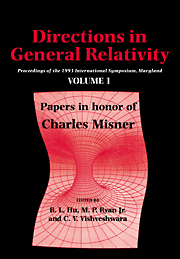 Directions in General Relativity
Directions in General Relativity Published online by Cambridge University Press: 03 February 2010
INTRODUCTION
The presumed breakdown of the general theory of relativity (GTR) at the Planck scale without, as yet, a complete quantum theory of gravity (QG) to replace it is used to motivate consideration of a simpler problem—the quantum mechanics of cosmological models. In a pioneering paper, Misner (1969a) coined the term “quantum cosmology” (QC) for the quantization of the dynamical system whose degrees of freedom describe a spatially homogeneous universe. He also introduced the term “minisuperspace” (MSS) (Misner 1972) for the finite-dimensional configuration space of the dynamics of homogeneous cosmologies—a finite subspace of Wheeler's “superspace” (Wheeler 1968), the space of all three-geometries. The first invocation of quantized MSS models was that of DeWitt (1967) to apply Dirac (1958, 1959) quantization of gravity to a tractable system. He considered the closed Friedmann-Robertson-Walker (FRW) model (see Misner et al 1973). Misner (1969a, 1970, 1972) considered the application of Arnowitt, Deser, and Misner (1962) (ADM) quantization methods to the Bianchi Type cosmologies (e.g. Ryan and Shepley 1975, MacCallum 1975). In both treatments, it became clear that issues of time, factor ordering, and interpretation which plague the canonical quantization of gravity survive in the truncated models. It was, of course, recognized that, while perfectly valid as classical solutions to Einstein's equations, quantized cosmologies where degrees of freedom have been zeroed by hand need have no relation to a true QG theory. [A systematic attack on the validity of the MSS “approximation” has only recently begun (Kuchař and Ryan 1986, 1989).] Misner argued (1969a) that one might reasonably expect the quantum universe to be dominated by the dynamics of its spatially homogeneous mode.
To save this book to your Kindle, first ensure [email protected] is added to your Approved Personal Document E-mail List under your Personal Document Settings on the Manage Your Content and Devices page of your Amazon account. Then enter the ‘name’ part of your Kindle email address below. Find out more about saving to your Kindle.
Note you can select to save to either the @free.kindle.com or @kindle.com variations. ‘@free.kindle.com’ emails are free but can only be saved to your device when it is connected to wi-fi. ‘@kindle.com’ emails can be delivered even when you are not connected to wi-fi, but note that service fees apply.
Find out more about the Kindle Personal Document Service.
To save content items to your account, please confirm that you agree to abide by our usage policies. If this is the first time you use this feature, you will be asked to authorise Cambridge Core to connect with your account. Find out more about saving content to Dropbox.
To save content items to your account, please confirm that you agree to abide by our usage policies. If this is the first time you use this feature, you will be asked to authorise Cambridge Core to connect with your account. Find out more about saving content to Google Drive.